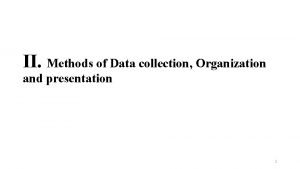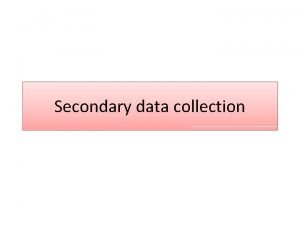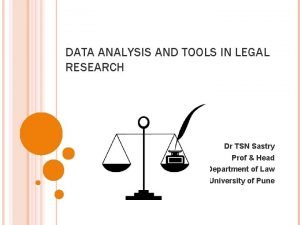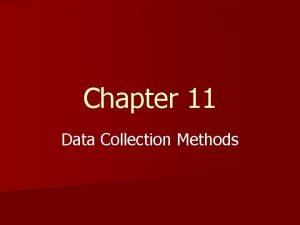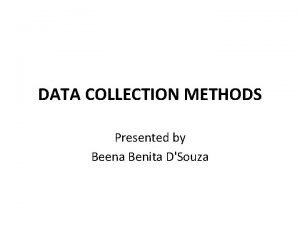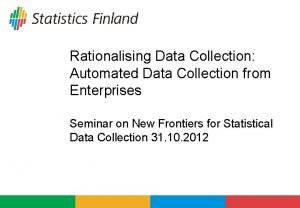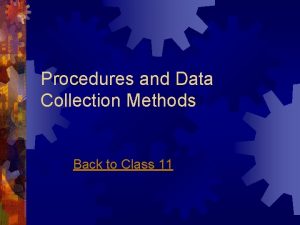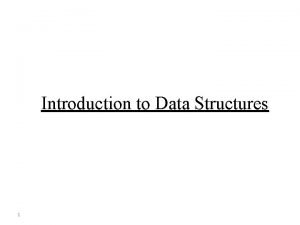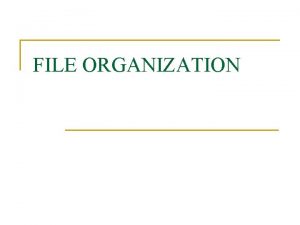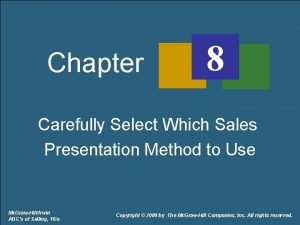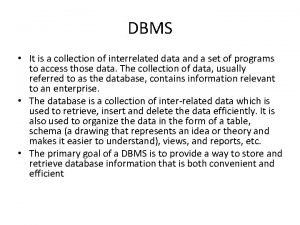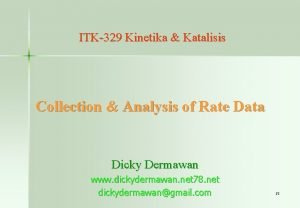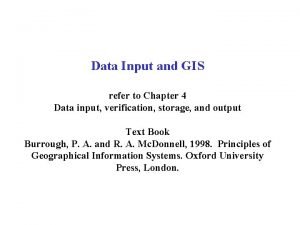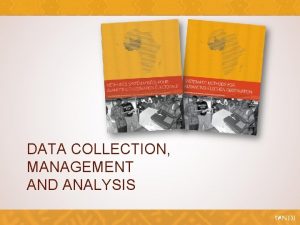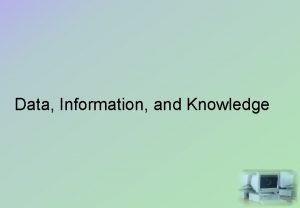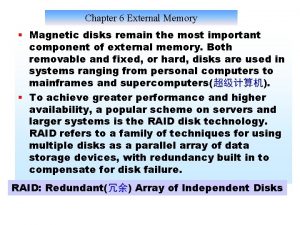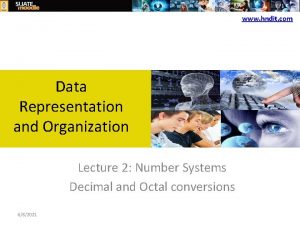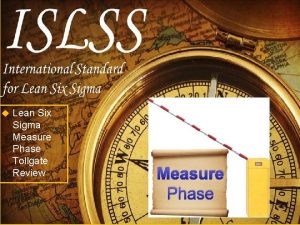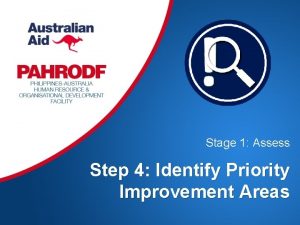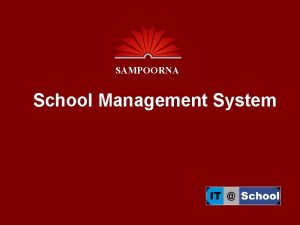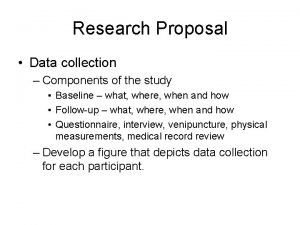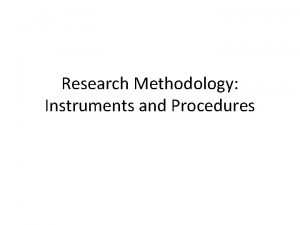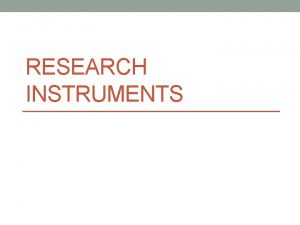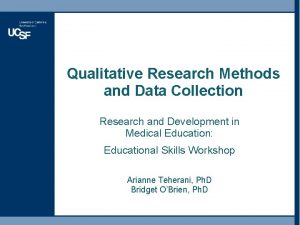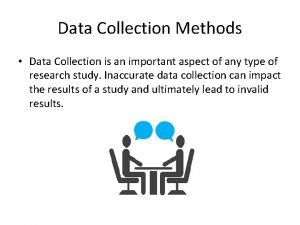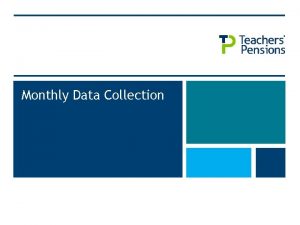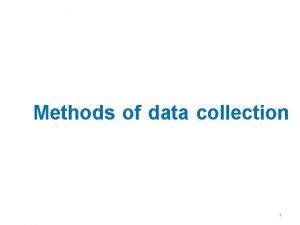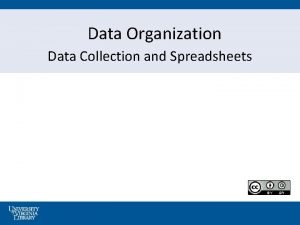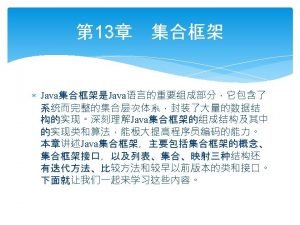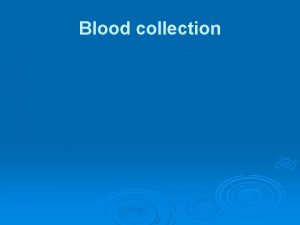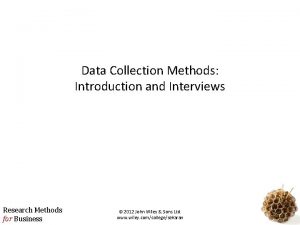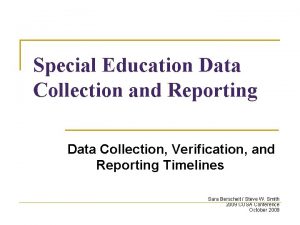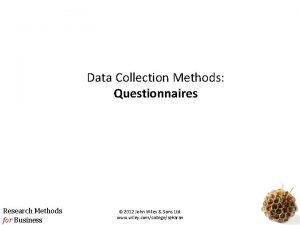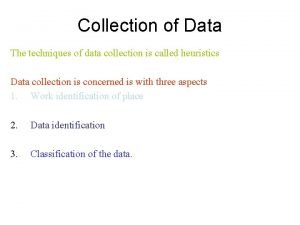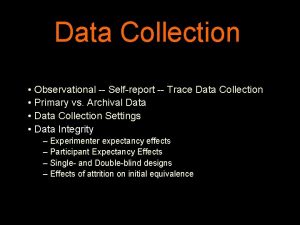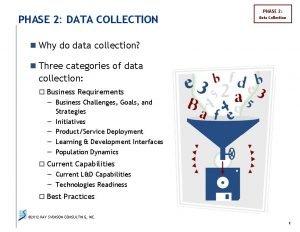II Methods of Data collection Organization and presentation







































- Slides: 39

II. Methods of Data collection, Organization and presentation 1

Discuss merits and demerits of the different data collection method you know? (5 minutes) 2

A. Data Collection Methods • Data collection techniques allow us to systematically collect data about our objects of study and about the setting in which they occur • In the collection of data we have to be systematic • If data are collected haphazardly, it will be difficult to answer our research questions in a conclusive way. 3

1. Observation • Involves systematically selecting, watching and recoding behaviors of people or other phenomena and aspects of the setting in which they occur • It includes all methods from simple visual observations to the use of high level machines and measurements, sophisticated equipment or facilities • Outline the guidelines for the observations prior to actual data collection 4

con’t… v. Advantages: Gives relatively more accurate data on behavior and activities v. Disadvantages: • Investigators or observer’s own biases, prejudice, desires • Needs more resources and skilled human power during the use of high level machines 5

2. Interviews I. Direct personal interview • The investigator presents himself /herself personally before the informant and questions him /her personally • Best suited to situations where problems are not completely understood and where questions can not be formulated before hand one question leads to other. Disadvantage • It is time consuming • It is not suited for large group of informants 6

Con’t. . a. More structured interview (Standardized technique ) • The wording and order of the questions being decided in advance. • This may take the form of a highly structured interview, in which the questions are asked orderly • usually preferred in community medicine research, since they provide more assurance that the data will be reproducible. 7

Con’t. . b. Unstructured interview : • Is flexible • The content wording and order of the questions vary from interview to interview. • The investigators only have idea of what they want to learn but do not decide in advance exactly what questions will be asked, or in what order. • Are characteristic of qualitative (non-quantitative) research. • May be useful in a preliminary survey, where the purpose is to obtain information to help in the subsequent planning of a study rather than factors for analysis, and in intensive studies of perceptions, attitudes, motivation and affective reactions. 8

Con’t… Interviewing using questionnaire • One drafts a detailed questionnaire • The investigator appoints agents known as enumerators, who go to the respondents personally with the questionnaire, • Ask them the questions given there in, and • Record their replies • They can be • Face-to-face or • Telephone interviews. 9

Face-to-Face Interviews Advantage • The interviewer knows exactly who is responding to the questionnaire • The interviewer can help the respondent if he/she has difficulty in understanding the questions e. g. language, concentration • There is more flexibility in presenting the items ; they can range from closed to open. • Observations can be made as well. 10

Con; t… Disadvantage • Untrained interviewer may distort the meaning of questions • Attributes of the interviewer may affect the responses given due to bias of the interviewer and his/ her social or ethnic characteristics. • More cost in terms of time and money (training and salary of interviewers). 11

Telephone interviews Advantage • Less expensive in time and money compared with face to face interviews • The interviewer is able to help the respondent if he/she doesn’t understand the question • Broad representative samples can be obtained for those who have telephone lines • May assure the uniformity if interviewer is the same. Disadvantage • Under presentation of those group which do not have telephone • Respondent may be substituted by another • Problems with questions with multiple options for answer and complicate questions 12

3. Questionnaires Self-administered questionnaires • Is simpler and cheaper • Can be administered to many persons simultaneously (e. g. to a class of students), and • Unlike interviews, can be sent by post Limitations • They demand a certain level of education and skill on the part of the respondents; • People of a low socio-economic status are less likely to respond to a mailed questionnaire 13

Post Questionnaire Method • The questionnaires are sent by post to the informants together with a polite covering letter explaining • The detail • The aims and objectives of collecting the information, and • Requesting the respondents to cooperate by furnishing the correct replies and returning the questionnaire duly filled in. • In order to ensure quick response, the return postage expenses are usually covered by the investigator 14

Con’t… The main problems with postal questionnaire are : • Response rates tend to be relatively low, and • There may be under representation of less literate subjects. 15

Mailed Questionnaire Method • In this method the questionnaire is mailed to respondents to be filled • Some times known as self enumeration Advantage • Cheap • No need for trained interviewers • No interviewer bias • They can be coordinated from one central location 16

Con’t… Disadvantage • Low response rate • Uncompleted questionnaires due to omission or invalid response • No assurance that the questionnaire was answered by right person • Needs intense follow up to get a high response rate 17

What to be considered before designing questioning tools üWhat exactly do we want to know, according to the objectives and variables we identified earlier? üOf whom will we ask questions and what techniques will we use? üAre our informants mainly literate or illiterate? üHow large is the sample that will be interviewed? 18

4. Documentary sources • Clinical and other personal records, death certificates, published mortality statistics, census publications, etc Examples : 1. Official publications of Central Statistical Authority 2. Publication of Ministry of Health and Other Ministries 3. News Papers and Journals. 4. International Publications like Publications by WHO, World Bank, UNICEF 5. Records of hospitals or any Health Institutions. 19

Con’t… During the use of data from documents • They are less time consuming and relatively have low cost. • However, Care should be taken on the quality and completeness of the data. • There could be differences in objectives between the primary author of the data and the user. 20

Problems in gathering data • Language barriers • Lack of adequate time • Expense • Inadequately trained and experienced staff • Invasion of privacy • Suspicion • Bias (project, person, season, diplomatic, professional) • Cultural norms (e. g. which may prohibit men interviewing women) 21

Choosing a method of data collection • Decision-makers need information that is relevant, timely, accurate and usable. • The cost of obtaining, processing and analyzing these data is high. • The challenge is to find ways, which lead to information that is cost-effective, relevant, timely and important for immediate use. • Some methods pay attention to timeliness and reduction in cost. Others pay attention to accuracy and the strength of the method in using scientific approaches. 22

Con’t… Practical considerations during selection of data collection methods 1) The need for personnel, skills, equipment, urgency 2) The acceptability of the procedures to the 3) The probability that the method will provide a good coverage 4) The investigator’s familiarity with a study procedure 23

Differences between techniques and tools Data collection techniques Data collection tools Using available information Checklist; data compilation forms Observation Eyes and other senses, pen/paper, watch, scales, microscope, etc. . Interviewing Interview guide, checklist, questionnaire, tape recorder Administering written questionnaire Questionnaire 24

B. METHODS OF DATA ORGANIZATION & PRESENTATION • The data collected in a survey is called raw data. • In most cases, useful information is not immediately evident from the mass of unsorted data. • Collected data need to be organized in such a way as to condense the information they contain in a way that will show patterns of variation clearly. • Precise methods of analysis can be decided up on only when the characteristics of the data are understood. • For this different techniques of data organization and presentation like order array, tables and diagrams are used. 25

Array (Ordered array) • Is a serial arrangement of numerical data in an ascending or descending order. • This will enable us to know the range over which the items are spread and will also get an idea of their general distribution. • It is an appropriate way of presentation when the data are small in size (usually less than 20). 26

Frequency Distributions • Frequency : The number of times each value occurs • Frequency distribution: A table which has a list of each of the possible values that the data can assume along with the number of times each value occurs. • Relative Frequencies: Express the frequency of each value or class as a percentage to the total frequency. 27

• Cumulative frequencies: When frequencies of two or more classes are added up, total frequencies. • Cumulative relative frequency: The percentage of the total number of observations that have a value either in that interval or below it. üIf we start the cumulation from the lowest size of the variable to the highest size, the resulting frequency distribution is called `Less than cumulative frequency distribution' , the most common. ü If the cumulation is from the highest to the lowest value the resulting frequency distribution is called `more than cumulative frequency distribution. ' 28

Frequency distributions • Present data in a relatively compact form • Gives a good overall picture • Contain information that is adequate for many purposes • But there are usually some things which can be determined only from the original data. 29

a) Qualitative variable • Count the number of cases in each category. • The ICU type of 25 patients entering intensive care unit at a given hospital 30

Con’t… For Nominal and Ordinal data • Frequency distributions are often used as a summary • The % of times that each value occurs, or the relative frequency, is often listed • Tables make it easier to see how the data are distributed 31

b) Quantitative variable -Select a set of continuous, non-overlapping intervals, usually of equal width such that each value can be placed in one, and only one, of the intervals. The construction of grouped frequency distribution consists 1. Choosing the classes, 2. Sorting (or tallying) of the data into these classes 3. Counting the number of items in each class, and 4. Displaying the results in the form of a chart or table 32

Con’t… 33

To determine the number of class intervals and the corresponding width, we may use Sturge’s rule: Where K = Number of class intervals W = Width (length) of the class interval L = The largest value S = The smallest value n = Number of observations NB: Ø Sturge's rule should not be regarded as final, but should be considered as a guide only. ØNo of classes specified by the rule should be increased or decreased for convenient or clear presentation 34

E. g. Leisure time (hours) per week for 40 University students: 23 24 18 14 20 36 24 26 23 21 16 15 19 20 22 14 13 10 19 27 29 22 38 28 34 32 23 19 21 31 16 28 19 18 12 27 15 21 25 16 Solution K = 1 + 3. 22 (log 40) = 6. 32 ≈ 6 Maximum value = 38, Minimum value = 10 Width = (38 -10)/6 = 4. 66 ≈ 5 35

Time (Hours) 10 -14 15 -19 20 -24 25 -29 30 -34 35 -39 Total Frequency 5 11 12 7 3 2 40 Relative Frequency 0. 125 0. 275 0. 300 0. 175 0. 050 1. 00 Cumulative Relative Frequency 0. 125 0. 400 0. 700 0. 875 0. 950 1. 00 36

Mid-Point of a class interval & the determination of Class Boundaries Mid-point or class mark (X c) of an interval The value of the interval which lies midway between the lower and the upper limits of a class. It is calculated as: Xc= Upper Class Limit+ Lower Class Limit 2 37

True limits (Class boundaries) Ø Are those limits, which are determined mathematically to make an interval of a continuous variable continuous in both directions, and no gap exists between classes. Ø Used for smoothening of the class intervals Ø The width of a class is found from the true class limit by subtracting the true lower limit from the upper true limit of any particular class. Ø Subtract 0. 5 from the lower and add it to the upper limit 38

Time (Hours) 10 -14 15 -19 20 -24 25 -29 30 -34 35 -39 Total True limit 9. 5 – 14. 5 – 19. 5 – 24. 5 – 29. 5 – 34. 5 - 39. 5 Mid-point 12 17 22 27 32 37 Frequency 5 11 12 7 3 2 40 39
 Data collection organization and presentation
Data collection organization and presentation Primary data collection
Primary data collection Types of data collection methods
Types of data collection methods Legal data analysis
Legal data analysis Observational data collection method
Observational data collection method Data collection methods observation
Data collection methods observation Automated data collection methods
Automated data collection methods Data collection procedure
Data collection procedure Collection methods and procedures
Collection methods and procedures Landsat collection 1 vs collection 2
Landsat collection 1 vs collection 2 Documentary collection
Documentary collection Data collection secondary data sources
Data collection secondary data sources Point by point organization example
Point by point organization example Indirect wax pattern
Indirect wax pattern Data structure operations
Data structure operations Methods of community organization
Methods of community organization Type of file organization
Type of file organization Process organization in computer organization
Process organization in computer organization 5cm labor
5cm labor Cephalic presentation
Cephalic presentation Canned sales presentation
Canned sales presentation Formula sales presentation
Formula sales presentation This is a collection of interrelated data and information
This is a collection of interrelated data and information Collection and analysis of rate data
Collection and analysis of rate data Data collection and input in gis
Data collection and input in gis Data collection management and analysis
Data collection management and analysis Raw facts
Raw facts Site:slidetodoc.com
Site:slidetodoc.com Design in output
Design in output Optical disk
Optical disk Data representation and organization
Data representation and organization Quantitative research examples
Quantitative research examples Data collection planning in the measure phase starts with
Data collection planning in the measure phase starts with Identify priority improvement areas
Identify priority improvement areas Finding answers through data collection module
Finding answers through data collection module Project sampoorna
Project sampoorna Data collection proposal
Data collection proposal It is the part where you indicate the research instrument
It is the part where you indicate the research instrument Research instruments
Research instruments Define data collection method
Define data collection method
